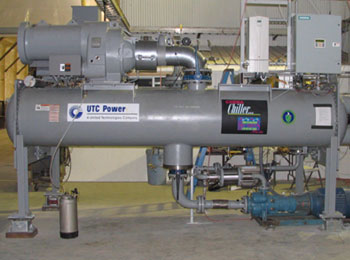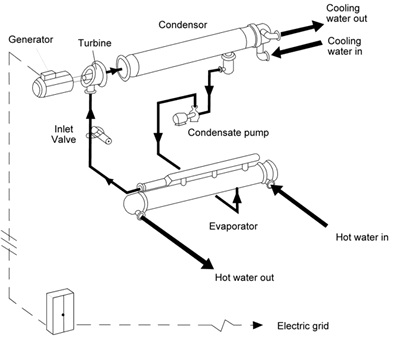UTC scores a big deal

280kw (225kw net) PureCycle Unit
In what must be the largest deal yet for the UTC PureCycle binary power unit, Raser Technologies has placed an order for 135 units for use in its developing projects.
Effectively, UTC is using its experience in the industrial chiller field to run the chiller backwards using the geothermal resource as input. What distinguishes the UTC approach from others is two fold: operating temperature range 74C (165F) to 150C (300F) and modularity. The units are designed to work individually or to be ganged up in pods as large as 40 units with 9MW net output. It’s really a nice product and Raser shows good business sense by heading this direction. And, it’s a really nice endorsement of the UTC product and approach.

Illustration of how a binary unit works
As you can see from the diagram above, the binary unit is pretty straightforward. Hot fluid comes in, the heat is transferred to a working fluid through a heat exchanger, the working fluid vaporizes and drives a turbine, the working fluid is then cooled and returned to be reheated, the geothermal fluid is (typically) injected back into the reservoir.
Changing gears for the moment, this has had some business impact. Let’s look at what this impact has had on Raser’s stock.
Even though this constitutes movement for Raser, the reaction that is occurring in the stock is nothing less than irrational exuberance. The stock is up at the time of this writing over 30%, and that brings a one month run up of nearly 100% in the stock. While I appreciate that Raser is making very important strides in making their geothermal portfolio a reality, the valuation is wildly mismatched to the fundamentals.
Let’s do some math. Let’s assume that Raser can bring on all 30MW of power in 2008, possible, but it will be a push. Using generous assumptions of power sale at $0.07/kwh and a capacity factor of 95% that would yield around $17.5M in gross power sales per year. On the cost side, wheeling, transmission, and congestion costs will be around $0.015/kwh and plant operations costs will be in the $0.03/kwh range leading to a cost of $0.045/kwh. We haven’t factored in SG&A, depreciation, or debt, but my guess is that’s going to be in the $0.015-$0.025/kwh range. Yes, there will be the Production Tax Credit benefit of $0.02/kwh which will effectively make this tax free earnings, but, the net margin will be rather low, let’s say Raser pockets $2.5M/year on this set of assets. At standard power company valuation of 18.3 times net earnings, that would support a $45.75M market cap for this operation – at Ormat valuation (perhaps a closer comp) of 40x net earnings, that would support a $100M market cap.
This entry is not intended to slam Raser, I’m happy to see the company take these steps and roll out press releases every few days, but I think the valuation of the issue is wildly mismatched to reality. Raser sports a market cap of $464M at present (7:30am PDT April 12, 2007.)
Caveat emptor.
Update 4/16/2007: There have been some questions about whether or not this is an attempt to value Raser Technologies as a whole, it is not. The author has no detailed knowledge of the symetron technology that Raser has developed. The only information that the author has is that there is $400,000 of sales to date of the technology with opportunity for wider adoption. Rightly, that technology should not be valued at $0. However, in the author’s opinion, neither does that technology serve to bridge the valuation gap between the current market cap of $400M and the in operation geothermal plant valuation of $100M. So while we’re not attempting a detailed valuation, common sense dictates that a $400k revenue stream, however promising, does not justify $300M in market cap and thus the author sticks to the conclusion that Raser, at present prices, is overvalued. What is a fair value? That would require in-depth knowledge of the symetron technology to derive a valuation and then simple addition to the geothermal operations.
One other topic this initial post did not cover adequately was resource development cost. According to our research, geothermal resources cost between $1.2M on the low end of the range to $6.7M per megawatt. The average price for projects developed in the US over the past 10 years is $4.3M per megawatt. Drilling costs are the major variable in those figures running at around $1,300 per meter. The UTC unit cost (list price) alone is $1.4M per megawatt. Make no mistake, these are expensive projects to develop.
Finally, resource quality comes into play. The lower the temperature the lower the pressure is likely to be in the production wells. That implies pumping to get the resource to the surface for use in the generation units. This increases parasitic loads. The Stillwater plant in Nevada is a 19MW gross operation, but up to 50% of the output is dedicated to parasitic load. So when valuing the 30MW installation, it is likely overly optimistic until a resource review shows that the parasitic load will allow for that output.
There have also been some comments indicating that this source is anti-Raser. That’s simply not the case. Raser, like any other company in this space has a market valuation and an intrinsic valuation. When there is a difference between those two values, it’s interesting to explore. This has previously been pointed out with a Raser competitor, Ormat. Though the disparity between the two values is not so large in that case. The author would like to point out again, that Raser is making good public steps in development of its projects, management seems to be making shrewd choices, and that at the right valuation, Raser could be a good long term investment.
Disclosure: The author holds no shares in UTC or Raser Technologies









here is what one person thinks raser is worth.
Harley:
You are entitled to your opinion, as is that blogger. As I mentioned earlier, I think he’s missed some items. If you’re looking to value the business; take a 20 year Discounted cashflow of the power sales & tax credits for the 30 megawatts and you’ll wind up with a Net present value of between $12 to $20 per share depending on what growth rate assumptions and weighted average cost of capital you utilize. Symetron is the wildcard here and can dwarf the goethermal opportunity.
This is taken from the yahoo message board:
http://messages.finance.yahoo.com/Stocks_%28A_to_Z%29/Stocks_R/threadview?m=ts&bn=28065&tid=6565&mid=6637&tof=2&frt=2
Any company hanging its hopes for profitability is a company in trouble. Also, it is important to note that one can not secure tax benefits greater than tax liability. Given that Raser already has an accrued $35M loss and that peak earnings on the 30MW projects is in the $17M range with around $2.5M in net income, at a tax rate of 30%, I don’t see great benefit to the company in valuation.
As a comp, look at Ormat (ORA), who has 377MW producing in their portfolio and ~$1.6B market cap. ORA has very little execution risk relative to any developer not in operation, including Raser. Can any investor say, without laughing, that Raser is worth 1/3 the value of Ormat without having drilled a hole or produced a kilowatt hour? Yes, there is the unknown of the motor technology, but adoption (and subsequent monetization) is certainly lagging development in that area….
We don’t provide buy/sell guidance on this site, but we do believe that intelligent investors examine appropriate information and then make choices. We are pointing out a LARGE discrepancy between RZ market cap and RZ likely intrinsic value. We are not saying that RZ will be unsuccessful as a developer, we are saying that the market has a way of appropriately valuing (typically based on earnings) any issue.
The question you should be asking yourself is: what does other baseload generation cost? You can only build new plants, so comparing levelised costs of older plants is not very useful for the future.
At USD 1400 per kWe, 10 percent discount, 95% capacity factor, no fuel costs, and 1-2 cents O&M, this gives a levelised busbar cost of 2.5 – 3.5 cents/kWh
New coal and nuke are highly unlikely to be under that in OECD countries. What’s more, this tech can compete in many markets with off grid diesel (island communities etc) which is even more sweet even at today’s low oil prices (they are going up again).